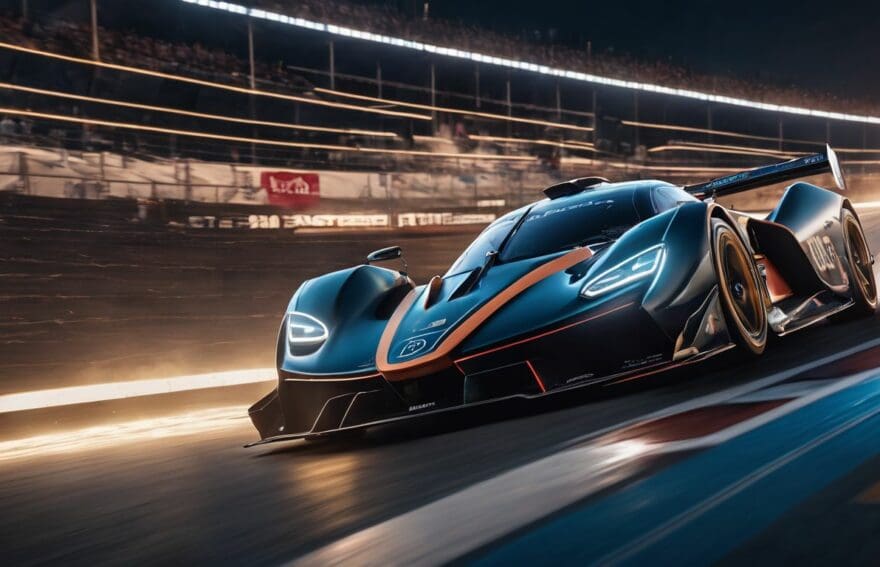Esports and Electric Vehicles: Racing into the Future

Updated On: November 13, 2025 by 
As aficionados of heart-racing spectacle, we’re constantly on the lookout for that electric surge in our racing experiences. Like many of you, we’ve keenly observed the tracks taking a fresh turn – with Formula E carving out an exhilarating path for electric motorsport.
In this blog, we’ll delve into how esports and electric vehicles are intertwining to chart a new course for the future of racing. We’ll share with you insights into the cutting-edge advancements and burgeoning opportunities that will get any enthusiast’s pulse racing.
So strap in and prepare to supercharge your love for the sport – it promises to be quite a ride!
The Rise of Electric Car Racing
The rise of electric car racing has been monumental, with the introduction of Formula E leading the charge in revolutionising motorsport. The Formula E experience has allowed for a new approach to racing and is propelling us towards an exciting electric horizon.
The Genesis of Formula E
Back in 2014, we witnessed the spark that ignited a new era in motorsport with the launch of Formula E. Pioneering sustainability and technology, this all-electric racing series charged onto the scene, redefining what it means to be entertained by speed and competition.
It wasn’t just about pushing boundaries on the track; it was also about setting a precedent for a cleaner future in auto racing.
We’ve seen Formula E grow rapidly, attracting major car manufacturers and cities eager to showcase electric vehicle innovation and performance. This isn’t merely another championship; it’s a vision coming to life where electric mobility is as thrilling as traditional motorsports but without leaving carbon footprints behind.
With each race, fans around the world join us in experiencing something far beyond traditional petrol-powered events – they are part of a revolution that’s changing how we think about transportation and our environmental responsibility.
Formula E Experience
Formula E offers a thrilling experience that is both cutting-edge and eco-friendly. The electric car racing championship has redefined the landscape of motorsport, captivating audiences with its innovative technology and sustainable approach.
Formula E races take place on temporary street circuits in major cities around the world, making it accessible to fans globally. With high-performance electric cars reaching speeds of up to 174 mph (280 km/h), the heart-pounding action keeps viewers on the edge of their seats throughout each race.
Additionally, Formula E features a unique “Attack Mode,” allowing drivers to temporarily boost their car’s power output by driving through designated zones on the track, adding an extra element of strategy and excitement to the competition.
Moreover, Formula E events are not limited to just racing; they offer a full-day festival experience with live music performances and interactive fan zones, creating an electrifying atmosphere for attendees.
As part of its commitment to sustainability, the championship also focuses on minimising its environmental impact by using low-carbon technologies such as glycerine generators for off-grid power at race events and biofuel solutions for logistics vehicles.
Racing Towards an Electric Horizon
Electric car racing is hurtling towards a greener, more sustainable future as Formula E expands its global influence and brings the thrills of electric racing to new audiences. The evolution in design and technology not only signifies a shift in speed and competition but also represents a broader transformation within the industry.
With the World Rallycross (WRX) looking optimistically towards an electric future from 2022, there’s ample opportunity for gamers to immerse themselves in the world of esports and motorsport as autonomous vehicles and electric cars take centre stage.
As we delve into the intersection of gaming, auto enthusiasm, and esports, it’s clear that exciting opportunities are emerging for passionate gamers as well as novices. This influx has the potential to revolutionise how fans experience racing games while promoting sustainability and fostering enthusiasm for electric vehicle adoption amongst wider audiences.
Moving forward, let’s explore how this intersection provides innovative ways for automotive enthusiasts to engage with gaming experiences alongside embracing a cleaner energy horizon.
The Intersection of Esports and Racing
Esports has made a significant impact on the world of motorsport, with virtual racing events gaining popularity and attracting a new generation of fans. Gamers now have opportunities to participate in real-life racing events through esports championships, making the transition from virtual to actual racing a reality for many.
The Impact of Esports on Motorsport
Esports has made a significant impact on motorsport, bringing virtual racing to the forefront and creating new opportunities for gamers passionate about racing. With the rise of esports championships like GT Racing, Le Mans 24 Hours, and Electric Esports Championship, gaming enthusiasts have found a platform to engage with their favorite motorsport events in an interactive way.
The intersection of gaming, auto enthusiasm, and esports is not only increasing the popularity of racing games but also introducing novice gamers to the world of motorsport in an immersive and accessible manner.
Electric vehicle racing has been further propelled into the limelight through various esports events, igniting interest among a wider audience. As electric car technology continues to evolve across different sectors including sports and gaming industries, it paves the way for more innovative changes in both realms.
Opportunities for Gamers in Racing
- Participate in Esports Racing Leagues that centre around electric car racing, such as Formula E and Veloce VEXT Web3 Token, providing a platform for us to showcase our gaming skills on a global stage.
- Engage with auto industry professionals and organisations as esports continue to intersect with motorsport, opening doors for collaboration and potential career paths within the racing industry.
- Embrace the evolving landscape of gaming by exploring new virtual experiences that blur the lines between traditional video games and real-world racing, offering immersive opportunities for us to engage with electric vehicle technology.
- Seize the chance to influence the future of racing content through platforms like Veloce VEXT Web3 Token, where users can vote on future content and have decentralised ownership of a race team, shaping the direction of digital racing ecosystems.
- Explore emerging innovations such as autonomous vehicle technology and integrated gaming features in electric cars, presenting unique avenues for us to delve into cutting-edge technologies shaping the future of both gaming and motorsport.
Promoting Sustainability
Dual impact of electric racing on both the environment and the automotive industry is significant, as it promotes sustainable practices and paves the way for electric mobility. The innovations in electric car racing also contribute to sustainability efforts through advancements in battery technology and additive manufacturing for race seats.
Dual Impact of Electric Racing
Electric car racing has a dual impact on the environment and the automotive industry. It not only promotes sustainable practices but also accelerates the development of electric mobility.
As Formula E expands globally, it brings the excitement of electric racing to new audiences, fostering enthusiasm for electric vehicles and promoting their adoption among a wider audience.
Moreover, with the World Rallycross (WRX) looking positively towards an electric future from 2022, the industry is embracing this shift, signifying a broader evolution in motorsport.
Porsche’s vision for the future of customer motorsport emphasises a commitment to sustainability and innovation. This transformation in design and technology represents more than just speed and competition; it signifies a fundamental shift towards environmentally friendly practices within the industry.
Paving the Way for Electric Mobility
The transition to electric racing is not just about thrilling competitions; it’s also about paving the way for electric mobility. As electric car racing gains momentum, it’s spurring innovation and pushing the boundaries of what’s possible with sustainable transportation.
With influential events like Formula E expanding globally, enthusiasts are increasingly drawn towards a future that embraces cleaner and more efficient means of mobility.
Electric racing has a dual impact on both the automotive industry and environmental sustainability. By promoting advancements in electric vehicle technology, it encourages the adoption of eco-friendly solutions while simultaneously capturing the imagination of gaming fans worldwide.
Innovations in Electric Car Racing
From high-end battery technology to integrated helmet features, the world of electric car racing is constantly evolving with cutting-edge innovations. Additive manufacturing for race seats also plays a crucial role in enhancing performance and safety on the track.
Additive Manufacturing for Race Seats
We can witness a significant shift in the design and production of race car seats through additive manufacturing. This innovative method allows for the creation of custom-fit, lightweight, and durable seats that enhance driver comfort and safety.
Additive manufacturing enables the use of advanced materials to achieve optimal performance while reducing overall weight, contributing to improved efficiency on the track. Moreover, this technology provides opportunities for rapid prototyping and customisation according to individual driver specifications, ultimately revolutionising the way race seats are designed and manufactured.
The integration of additive manufacturing in race seat production is not only enhancing driver experience but also pushing boundaries in material science and engineering. With its potential to deliver bespoke solutions tailored to each driver’s unique requirements, this advancement underscores the dynamic evolution taking place within electric car racing design and technology.
High-End Battery Technology
Moving from the innovative approach of additive manufacturing for race seats, high-end battery technology is another game-changing aspect in electric car racing. The advancements in battery technology are revolutionising the performance and efficiency of electric vehicles on the track.
With a focus on enhancing power output and extending range, these cutting-edge batteries are driving the evolution of electric car racing by providing teams with enhanced capabilities for high-speed competition.
These developments are not only reshaping the landscape of motorsport but also contributing to promoting sustainability, aligning with the broader goal of reducing environmental impact while delivering thrilling racing experiences.
The integration of high-end battery technology has not only elevated the performance standards in electric car racing but also paved the way for showcasing the potential of electric mobility to a wider audience.
Integrated Helmet Features
Integrating advanced technology into racing gear has become a game-changer, especially when it comes to helmet features. For instance, innovative helmets now come equipped with heads-up displays providing vital race information right in the driver’s line of sight.
This includes real-time data such as lap times, speed, and even virtual overlays of upcoming corners on the track. Additionally, some helmets offer built-in communication systems facilitating seamless interaction between drivers and their teams during high-speed races.
Furthermore, integrated safety technologies add another layer of protection for racers. These helmets are designed with impact-resistant materials that can mitigate head injuries while maintaining aerodynamic efficiency crucial for competitive racing.
The Future of Electric Car Racing
The potential of autonomous racing is an exciting prospect, and we explore the path to pursuing a career in motorsport. Learn more about the thrilling future of electric car racing by reading our full blog.
The Potential of Autonomous Racing
Autonomous racing holds immense potential to revolutionise motorsport, amplifying both the thrill of competition and the technological ingenuity at play. The integration of advanced AI systems in racing vehicles is set to push the boundaries of speed and precision, providing an exhilarating showcase of cutting-edge innovation.
This innovative approach is not only reshaping the landscape of motorsport but also offering a glimpse into the future possibilities of transportation technology as a whole. With rapid advancements in autonomous driving capabilities, we are on the brink of witnessing an entirely new dimension of high-speed racing that merges adrenaline-fuelled action with groundbreaking automation technologies, paving the way for a captivating era in competitive automotive sports.
The evolution towards autonomous racing presents an exciting opportunity for gamers and enthusiasts alike to immerse themselves in an unprecedented realm where human skill meets machine intelligence.
As esports continue to intersect with traditional motorsport, aspiring racers can anticipate a dynamic blend of gaming expertise and real-world driving prowess as they navigate this thrilling frontier.
The Path to Pursuing a Career in Motorsport
Aspiring to a career in motorsport is an exhilarating journey that offers many opportunities and challenges in the exciting world of racing. To carve out a successful path, consider these essential steps:
- Explore Your Passion: Immerse yourself in the world of motorsport by attending races, staying updated on industry news, and understanding different racing formats.
- Gain Knowledge and Skills: Enrol in motorsport engineering courses, driving schools, or mechanics training programmes to develop a profound understanding of racing dynamics and technology.
- Build a Professional Network: Engage with industry professionals at events, join motor clubs, and seek mentorship from experienced individuals to establish strong connections within the racing community.
- Pursue Internships and Volunteering: Gain practical experience by interning with racing teams, volunteering at events, or working at race tracks to learn the ins-and-outs of motorsport operations.
- Choose a Specialisation: Identify your strengths and interests within motorsport – be it as a driver, engineer, mechanic, or team manager – and focus on honing those skills for your chosen career path.
- Showcase Your Talent: Participate in amateur races or competitions to demonstrate your capabilities and passion for motorsport while building a competitive portfolio.
- Seek Sponsorship Opportunities: Explore partnerships with brands or businesses willing to support your journey into motorsport through financial backing or in-kind sponsorships.
- Stay Resilient and Persistent: Understand that breaking into the competitive world of motorsport requires determination, continuous learning, and unwavering dedication to achieving your goals.
- Promoting Sustainability
Conclusion
The future of electric car racing is bright, with Formula E expanding its global reach. Electric racing design and technology are evolving, representing a broader shift in the industry.
Esports and electric vehicle racing create new opportunities for automotive and gaming enthusiasts. The intersection of gaming, auto enthusiasm, and esports is revolutionising the world of motorsport.
Electric car racing fosters enthusiasm for sustainability and promotes the adoption of electric vehicles among a wider audience.
FAQs
1. What connection exists between esports and electric vehicles?
Esports and electric vehicles connect through racing games, where gamers can compete in events like the Le Mans 24 Hours using virtual eco-friendly cars.
2. How does the rise of esports impact the climate change conversation?
As esports focus on online gaming with electric vehicles, it highlights climate change by promoting environmentally friendly alternatives to traditional car racing.
3. Is the gaming industry adopting themes around electric vehicles?
Yes, within esportsgamingtech, developers are increasingly incorporating electric vehicle races into their titles to mirror real-life advances and interests.
4. Can I participate in racing esports with an electric vehicle theme?
Absolutely; players worldwide join in racing esports leagues that simulate driving high-performance electric cars right from their own homes.


